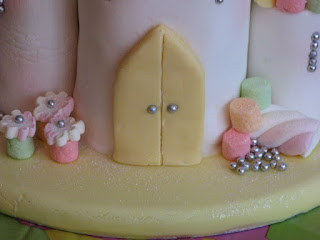I had an idea of what I wanted it to look like (almost one of the first images of a cake I ever downloaded from the internet and virtually my first pin in Pinterest) and decided to bake the sponge (gluten free so Jase could share it) in small pyrex ramekins, rather than bake a larger cake which would have to be cut to size after baking. A small victoria sponge mix (4oz each of flour, margarine and sugar plus 2 eggs) filled four ramekins perfectly. The only disadvantage of using the ramekins was that they flare outwards slightly, so I did need to trim the baked sponges to be straight-edged, but that was a minor point for something that actually worked very well.
The sponges were quite tall, so I used two cakes and sliced them in half horizontally, creating four layers. This did make quite a tall cake which proved tricky when it came to covering with fondant. The height of the cake (in relation to the diameter of the top) meant that the fondant hung in pleats around the bottom when I placed it on and it started cracking towards the bottom of the cake when I began to smooth it. The first attempt cracked so much that I decided to lift it off and start again with another piece. This worked much better and although it still cracked a little, I was able to cover these cracks with the pink fondant bow around the bottom of the cake.
I was pleased with how the flower on the top came out, although I should have left the layers to dry slightly longer as the petals started breaking away from the middle part of the flower. This didn't show when it was all put together and I was pleased with how the petal edged looked after I had "frilled" them.
I had two other sponges left so decided to make one more (smaller) cake and the decoration for this was also inspired by a Pinterest pin (two pins in one go - my pin to make ratio must be quite high!)
This one has a dahlia type flower on the top made from cutting mini marshmallows in half diagonally and dipping in edible glitter. The glitter only sticks the inside cut part, and the result is a pretty, glittery petal. I then put a blob of buttercream on the top (I wasn't going to make royal icing just for that) and placed the "petals" in circles, starting at the outside and working my way in. Again, such a simple but very pretty cake.
And for those of you keeping count (I only used three of the four sponges I baked), I filled the last sponge with lemon curd and buttercream and we all shared it for tea!
© 2012 Nicola Noble: Please observe the rules of copyright and blog etiquette. If you use my ideas or images, please link back to my blog. And do let me know - I'd love to take a look.

















